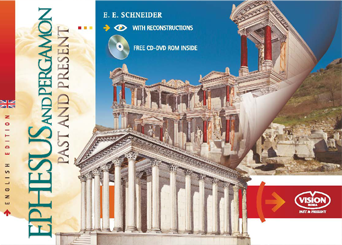The Hellenistic temple of Artemision– According to the ancient accounts, the temple was destroyed by a fire, set by a madman named Herostratus in 356 B.C., on the same night Alexander was born.
The fire caused great damage, because the ceiling of the temple was made of wood; we also know that Alexander, before leaving for the expedition against the Persians, made a sacrifice amidst the temple ruins and offered to shoulder the costs for the rebuilding, an offer which was courteously turned down by the Ephesians.
The new temple, whose architect was Cheirokrates (or, according to another interpretation, Deinokrates, Alexander’s architect), was erected on the foundations of the previous one, with the difference that it was raised by 13 steps, while the archaic building had a rather low platform, which was inadequate for the weak nature of the soil.
There was the same number of new columns with reliefs as in the previous version; according to the most common interpretation of a passage by Pliny the Elder (Nat. Hist., XXXVI, 21, 95), the height must have reached 18.40 meters, and one of the columns was allegedly carved by Scopas, the famous sculptor born on Paros, who lived between 420 and 340 B.C.

© Photo credits by Alexander van Loon under CC-BY-SA-2.0
The peristasis kept, on the wings, the dipteral arrangement of the older building (with two rows of columns), but the western façade now had three rows of columns. An examination of coins has made it possible to establish that the front pediment was decorated with sculptures and a graphic reconstruction has been attempted.
It is this temple of the 4th century B.C. that was considered one of the seven wonders of the ancient world, and which Pliny called “the light of Asia”.
The entire sanctuary must have contained many other sculptures and paintings also; according to the Greek scholar Strabo, Praxiteles was believed to have worked on the altar.
The richness of the donations made to the goddess also made the sanctuary one of the region’s most important economic and banking centers.

Do you want to know more about the history of Ephesus and Pergamon?
Check out our guidebook to Ephesus and Pergamon, with detailed history and Past & Present images of their greatest historical and archaeological sites.

